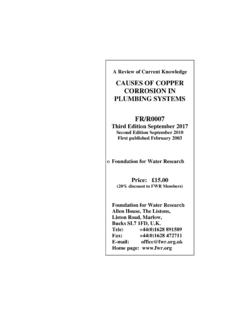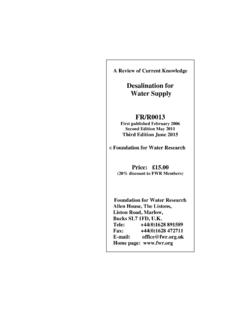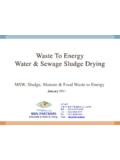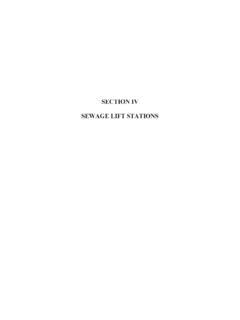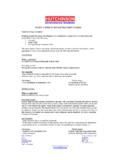Transcription of SEWAGE SLUDGE: Operational and Environmental …
1 A Review of Current Knowledge SEWAGE sludge : Operational and Environmental Issues FR/R0001. First published June 1999. Second Edition November 2001. Third Edition October 2011. Fourth Edition June 2016. Foundation for Water Research Price: (20% discount to FWR Members). Foundation for Water Research Allen House, The Listons, Liston Road, Marlow, Bucks SL7 1FD, Tele: +44(0)1628 891589. Fax: +44(0)1628 472711. E-mail: Home page: Review of Current Knowledge This review is one of a series of Reviews Of Current Knowledge (ROCKs). produced by FWR. They focus on topics related to water supply, wastewater disposal and water environments, which may be the subject of debate and inquiry. The objective of each review is to produce concise, independent scientific and technical information on the subject to facilitate a wider understanding of the issues involved and to promote informed opinion about them.
2 Foundation for Water Research 2016. Copyright Apart from any fair dealing for the purposes of research or private study, or criticism or review, as permitted under the UK Copyright, Designs and Patents Act (1998), no part of this publication may be reproduced, stored or transmitted in any form or by any means, without the prior permission in writing of FWR. Disclaimer Whilst every effort has been made to ensure accuracy FWR will not accept responsibility for any loss or damage suffered by any person acting or refraining from acting upon any material contained in this publication. Appropriate professional advice should be sought when making important decisions to ensure the information is correct, up-to-date and applicable to specific circumstances.
3 Review of Current Knowledge SEWAGE sludge . (also called wastewater biosolids). Thermal hydrolysis pretreatment (149000 tDS/y) with mesophilic anaerobic digesters (17000 m3) behind at Blue Plains Water Resource Recovery Facility, Washington DC, USA. Author: Dr T. D. Evans 1. Review of Current Knowledge Contents 1 Introduction .. 3 2 How sludge is produced .. 7 3 sludge as a resource .. 10 Water .. 10 Energy .. 10 Chemicals, metals, etc.. 10 4 sludge treatments .. 13 Dewatering .. 13 Biological treatments .. 16 Chemical treatment .. 20 20 Incineration and other thermal processes .. 21 5 Risks of using sludge on land .. 26 Metals and inorganic chemicals .. 27 Organic chemicals .. 28 Biological risks pathogens .. 30 Odour .. 33 Unknown' risks .. 33 Emerging' risks.
4 34 6 Benefits of using sludge on land .. 35 Nutrients .. 36 Organic matter .. 37 7 Conclusions .. 39 8 References .. 41 Appendix I Production and use of SEWAGE sludge in the EU .. 44 Appendix II Production and use of SEWAGE sludge in Europe .. 45 Appendix III Examples of risks involved in normal activities .. 46 2. Review of Current Knowledge 1 Introduction This ROCK is concerned primarily with sludge from urban and domestic wastewater treatment works, also called [after it has been treated] wastewater biosolids. As much as 50% of the dry matter in sludge can be surplus biomass grown in the course of treatment. Many of the principles will also apply to sludges from wastewaters from industrial processes and also to digestates from biogas plants. The main objective of treating these wastewaters has been to separate water and the other constituents so that the water is fit for release back to the environment, or for reuse (Figure 1).
5 A second objective is to recover resources from the other constituents. This is being given increasing priority as we strive to move from being a disposal society to a recycling society; from a linear to a circular economy. It is important to keep in context the risks and benefits compared with ambient activities and with not recycling. To emphasise the point the Water Environment Federation uses the term Water Resource Recovery Facilities (WEF, 2014). Figure 1 SEWAGE taken from the inlet and effluent (reclaimed water) from the outlet of Mogden WwTW. 3. Review of Current Knowledge sludge contains organic matter, nitrogen, phosphate, some potassium, magnesium, sulphur and the minor plant nutrients, which means that it is valuable as a soil improver for agriculture, land restoration, forestry, and other land-based activities.
6 It also contains gold, silver, platinum and other metals and is a good substrate for biogas production. Westerhoff, et al. (2015) reported that, if they could all be recovered, the metals in sludge for a community of 1 million people would be worth about US$13 million annually but the questions for anybody considering this are whether there is a sufficient quantity of sludge and whether metals are present in concentrations and chemical forms that make recovery financially viable. Figure 2 Earth System Boundaries (credit UCL). As Figure 2 shows, we are exceeding the earth system boundaries for fixed nitrogen by 6 times and for phosphorus by 5 times. These are abundant in SEWAGE sludges and it is environmentally responsible to recover or recycle the N and P in wastewater and sludges.
7 Phosphate is the more important because it is irreplaceable whereas nitrogen gas is abundant in the atmosphere (albeit biological activity or energy is needed to fix it). Phosphate is essential for life because it is part of DNA and cells' energy pathways. It can never be substituted. Children accumulate phosphate in their bones, teeth, etc. but adults excrete 98% of the phosphate in their diets because they are just turning over cells. This and other phosphate ends up in urban wastewater. At the current rate of extraction, today's phosphate mines will be exhausted by the end of this century. Estimates of future 4. Review of Current Knowledge reserves range from 200 to 400 years (Rosemarin et al., 2010); this is not long in the history of human kind.
8 Morocco and Western Sahara have the largest proportion of the world's reserves (about 60% of the total). The USA (11%) and China ( ) have both implemented measures to restrict exports because they have realised the strategic significance of phosphate. As regards threats to the human population, phosphate depletion is on a par with climate change. As Isaac Asimov explained: life can multiply until all the phosphorus is gone, and then there is an inexorable halt which nothing can prevent . We may be able to substitute nuclear power for coal, and plastics for wood but for phosphorus there is neither substitute nor replacement. (Asimov, 1974). Anaerobic digestion of SEWAGE sludge became established from the beginning of the 20th century. The biogas produced is about 65% methane and because of this it is valuable as continuous, base-load, non-fossil energy, irrespective of time of day, time of year or weather.
9 It can be upgraded to biomethane or biohydrogen. SEWAGE sludge is also a good base medium for digesting with other organic residuals [biowastes]. It was SEWAGE collection and treatment (public health engineering) that cut waterborne disease and increased life expectancy in towns and cities in the mid- 19th century, so it is no surprise that untreated SEWAGE sludge contains pathogens (disease causing organisms). Therefore appropriate practices and procedures are necessary for treating and using sludge , just as they are for manures. The content and species of human pathogens in SEWAGE sludge reflects the health of the population. By contrast, some animals can have symptomless infection with organisms that are extremely pathogenic to humans ( Escherichia coli O157:H7 in cattle), the organisms are present in manure but not in sludge .
10 It is possible to find in SEWAGE sludge and biosolids measurable amounts of most of the chemicals used in society. However, mere presence is not the question; the question should be whether there is unacceptable risk. As Paracelsus said five hundred years ago the dose makes the poison . SEWAGE sludge might be a source but is there a receptor and is the concentration sufficient and is there a pathway to deliver a harmful dose to that receptor? In the case of SEWAGE sludge produced in developed countries and used or disposed in accordance with today's rules, the consensus of informed scientific opinion is that the answer to this question is no'. Through a combination of hazardous substances regulations, which have eliminated some chemicals, changes in industrial practices and restricting 5.
